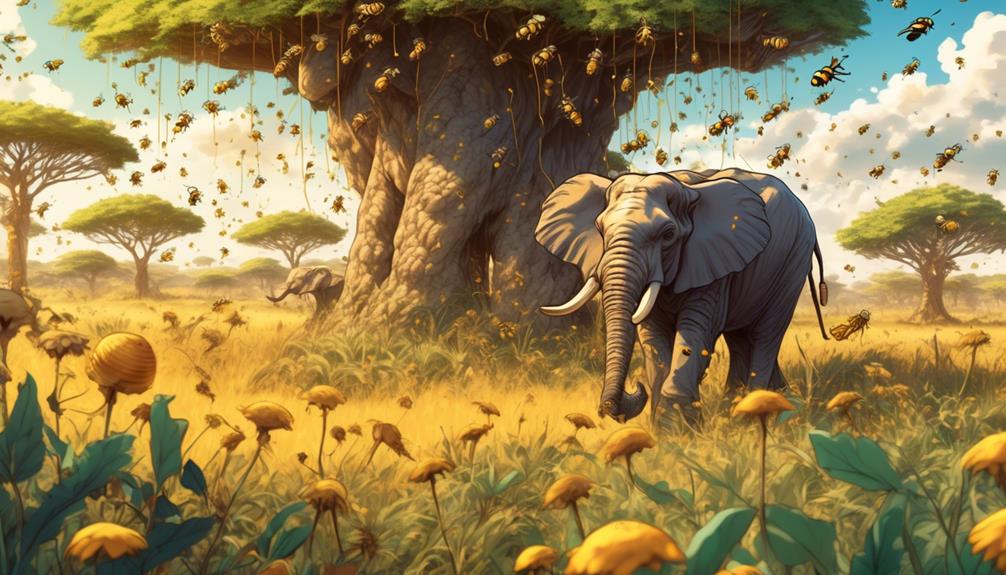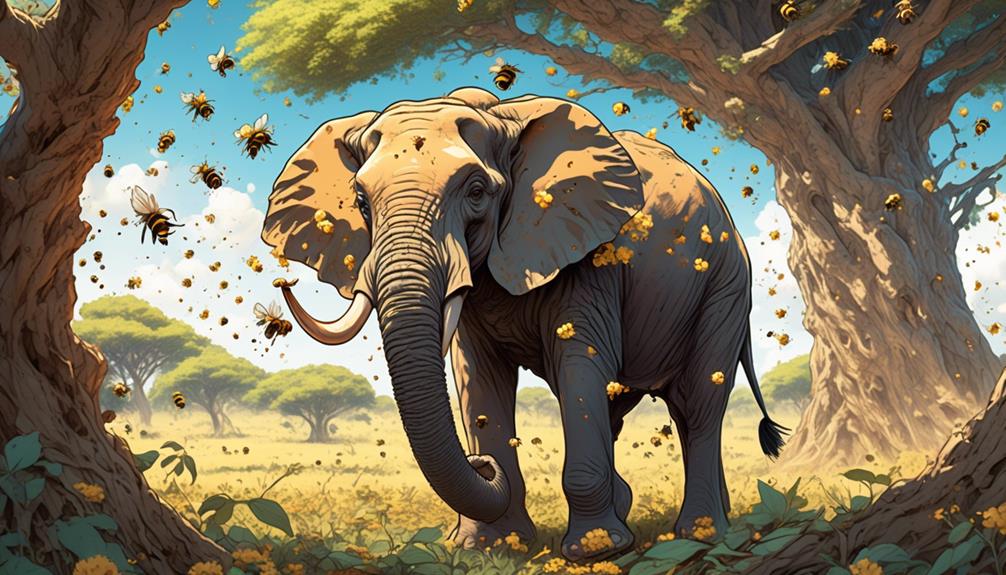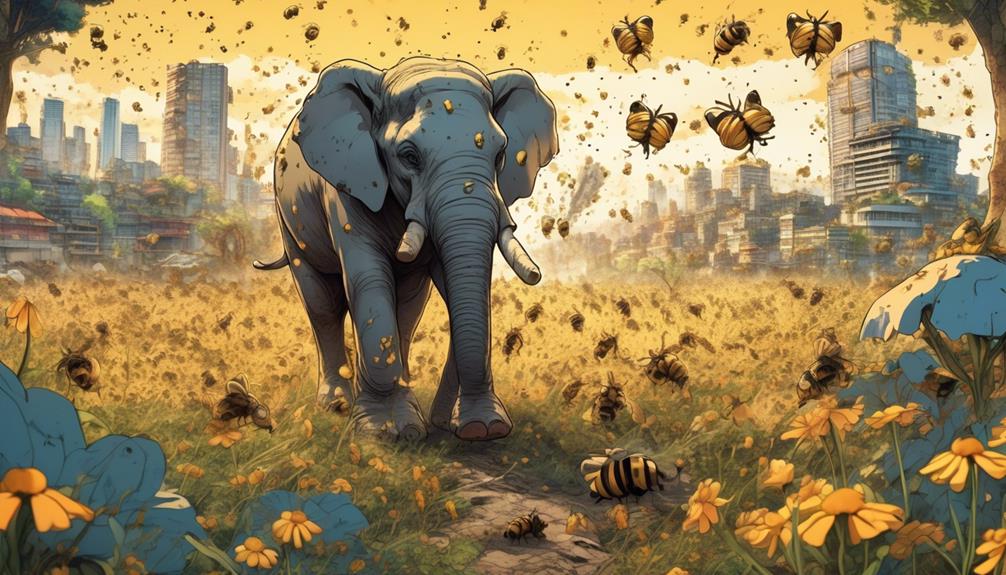Keeping giants in check, discover why bees, the tiny powerhouses, paradoxically intimidate the colossal elephants in this fascinating biological mystery.

Why Do Elephants Avoid Bees?
Imagine the world of nature as a grand chess game, where each species has its unique role to play.
You'd think the mighty elephant, the king of the jungle, wouldn't fear anything. Yet, a tiny creature, the bee, manages to keep it in check. It's a fascinating interaction that has puzzled scientists and nature enthusiasts alike.
Why do these towering giants avoid bees, which are merely a speck in comparison to their colossal size?
As we peel back the layers of this biological mystery, you'll discover a world where size doesn't always equate to power and where the smallest beings can wield significant influence.
Just keep in mind, not all questions have straightforward answers.
Key Takeaways
- Elephants have a natural aversion to the sound of buzzing bees and associate it with the risk of being stung.
- Elephants learn this aversion from their elders and even mimic the sound of bees as a deterrent for potential threats.
- The interaction between elephants and bees is deeply ingrained in the elephants' survival strategy, and they make decisions based on risk assessment and discomfort avoidance.
- Beehive fencing, which utilizes the presence of bees as a natural deterrent, is an effective strategy to reduce human-elephant conflicts and crop damage while promoting a healthier relationship between humans and elephants.
Understanding Elephant Behavior

To grasp the complexity of elephant behavior, it's crucial to analyze their interaction with their environment, like their surprising aversion to bees, which provides insightful data on their decision-making processes. You might think that these colossal creatures wouldn't pay mind to tiny insects, but in reality, they've developed a distinct behavioral response to avoid them.
Research indicates that elephants respond to the sound of buzzing bees by flapping their ears, shaking their heads, or even fleeing. This behavior isn't innate, it's learned. Young elephants observe and imitate the reactions of their elders, thus integrating this aversion into their behavioral repertoire.
What's more, elephants have been observed creating low-frequency rumbles that sound similar to a swarm of bees. This clever mimicry suggests that they use it as a deterrent for potential threats.
This aversion to bees isn't a random quirk, but a byproduct of their evolutionary adaptation. Bees can sting sensitive areas like the inside of an elephant's trunk, causing considerable discomfort. Therefore, their avoidance behavior showcases their capability to make decisions based on risk assessment and discomfort avoidance. So, in essence, it's not just about bees, but a testament to their complex cognitive capabilities.
The Elephant-Bee Interaction

Building on this understanding of elephants' keen decision-making abilities, let's examine the intricate dynamics of the elephant-bee interaction more closely. When elephants encounter beehives, they exhibit a unique behavior. They're not just randomly scared; they're making a calculated decision to avoid a potential threat. You see, elephants have evolved to associate the buzzing sound of bees with the risk of being stung.
How do we know this? Well, scientists have conducted experiments using audio playback. When the sound of buzzing bees was played, elephants would retreat, demonstrating their innate aversion to bees.
Here's a table summarizing key aspects of this interaction:
Behavior | Triggers | Effects |
|---|---|---|
Elephant retreat | Buzzing sound of bees | Avoidance of potential threat |
Elephant communication | Detection of bees | Alerting herd members |
Elephant marking | Successful evasion | Leaves scent marks to warn others |
Bee aggression | Elephant proximity | Defends hive by stinging |
This interaction shows a fascinating evolutionary adaptation. The elephants' ability to interpret sounds and make informed decisions ensures their survival. It's a clear demonstration of the complexity of nature's balance, and how every creature, big or small, plays a part in it.
Scientific Studies on the Phenomenon

Often, you'll find scientists delving into the intricate dynamics of the elephant-bee interaction, conducting various studies that shed light on this fascinating phenomenon. Harvard University, for instance, conducted a comprehensive study where they played the sound of bees to elephants. The elephants' immediate instinct was to retreat, indicating a natural aversion to bees.
Another study by Save the Elephants and Disney's Animal Kingdom took this further, demonstrating that elephants not only flee from the sound of bees, but they also emit a specific warning call that alerts other elephants of the presence of bees. This call isn't used in response to other threats, suggesting a unique communication code for bees.
Further research by Oxford University found that African elephants often shake acacia trees, but they're careful to avoid those with beehives. It's noteworthy that the elephants were even found to distinguish between acacia trees with and without bees from a distance.
These studies highlight that elephants' avoidance of bees isn't just mere coincidence, but a behavior deeply ingrained in their survival strategy. It's also an effective natural deterrent, which you'll find being used in Africa to prevent elephants from raiding crops. This not only protects the crops, but also reduces human-elephant conflicts.
The Role of Bees in Elephant Conservation

Harnessing the elephants' inherent fear of bees, researchers and conservationists have turned this instinctive behavior into an innovative strategy for elephant conservation. You might wonder, how exactly does this work?
Here's the science behind it: By installing beehives on the perimeters of farmlands, they've created a natural deterrent for elephants. These gentle giants, keen to avoid the sting of bees, steer clear of these areas, thus reducing human-elephant conflict and crop damage. It's a simple, yet effective method called 'beehive fencing'.
But that's not all. These beehives aren't just elephant repellents; they're also sources of income for the local communities. The honey harvested from these hives can be sold, generating additional revenue while fostering a healthier relationship between humans and elephants.
Furthermore, this strategy contributes to biodiversity conservation. Bees play a crucial role in pollination, making them essential for the survival of various plant species. By encouraging bee populations, we're supporting ecosystem balance.
In essence, bees prove to be an unlikely hero for elephant conservation. They've become instrumental in resolving human-elephant conflicts, promoting local livelihoods, and preserving biodiversity. That's the power of strategic, nature-based solutions.
Bees as a Natural Deterrent

In the face of looming elephants, it's the humble bee that emerges as an unlikely sentinel, effectively discouraging the pachyderms from venturing into human settlements and farmlands. You might be wondering how bees manage to deter such colossal creatures. It's all about the bees' stings. Elephants, despite their thick skin, are incredibly sensitive to bee stings, especially around their eyes and inside their trunks.
Consider the following table illustrating the deterrent effect of bees on elephants:
Elephant Behavior | With Bees | Without Bees |
|---|---|---|
Approach farm | Rare | Common |
Damage crops | Minimal | Extensive |
Attack humans | Unlikely | Possible |
As you can see, the presence of bees significantly alters elephant behavior, effectively reducing human-elephant conflict and crop destruction. This natural deterrent is not only efficient but also sustainable and non-lethal, making it a preferred conservation strategy. Further understanding of this relationship is therefore critical in elephant conservation efforts, ensuring both the survival of these magnificent creatures and the protection of human lives and livelihoods.
Impact on Human-Elephant Conflicts

You'll find that the bee-elephant dynamic significantly mitigates human-elephant conflicts, primarily by reducing crop devastation and potential attacks on humans. The aversion elephants have towards bees is leveraged as a form of natural deterrent, helping to guard agricultural lands from these massive creatures.
This approach, you'll notice, isn't only non-violent but also eco-friendly. It strengthens the local bee populations, indirectly aiding pollination and local biodiversity. Additionally, honey production becomes an alternative source of income for the local communities.
However, it's crucial to understand the limitations of this method. It's less effective for mature crop raiders who've learned to withstand the bee stings. There's also the risk of bees becoming a nuisance to the local communities themselves, particularly for individuals allergic to bee stings.
Frequently Asked Questions
What Are the Other Threats That Elephants Face in the Wild?
Aside from bees, elephants face numerous threats in the wild. Poaching for ivory is a significant issue, as is habitat loss due to deforestation and human encroachment. They're also affected by climate change, which alters their food and water sources.
Human-elephant conflict often results in fatalities, too. Additionally, disease and predation by large carnivores can be threats, especially to young or weak individuals.
It's a tough world out there for elephants.
What Other Natural Predators or Deterrents Do Elephants Have Besides Bees?
Besides bees, elephants have other natural predators and deterrents.
You'll find that crocodiles can pose a threat to young or weak elephants near water. Lions, too, occasionally target young, old, or sick elephants.
Moreover, elephants often avoid areas with loud noises or sudden movements, such as areas populated by humans. They're also deterred by extreme weather conditions and scarcity of food and water.
It's an intricate web of survival in the wild.
How Do Elephants Communicate With Each Other?
You might find it fascinating to learn that elephants communicate in complex ways. They use a mix of vocalizations, body language, and even seismic signals. These signals are low-frequency rumbles that they feel through their feet. It's an intricate language, conveying everything from joy to distress.
They're also known to use touch and smell for communication. So, when you see elephants intertwining trunks, they're not just playing – they're communicating.
How Can Humans Help in the Conservation of Elephants?
You can contribute to elephant conservation in several ways.
Firstly, support organizations that protect elephant habitats. They can't survive without their natural environment.
Secondly, educate others about the threats elephants face, like poaching and habitat degradation.
Lastly, don't support industries that exploit elephants for tourism or entertainment. It's critical to understand that these majestic creatures need our help to thrive.
Together, we can make a significant difference.
What Are the Other Ways That Bees Contribute to the Ecosystem Other Than Deterring Elephants?
Bees play a vital role in the ecosystem beyond just deterring elephants. They're key pollinators, enabling plants to produce fruit and seeds. Without bees, food production would significantly decline.
They also contribute to the biodiversity of our environment, as many species rely on their pollination.
Plus, bees produce honey and wax, which are used in various industries.
Conclusion
So, you've seen how elephants avoid bees. Studies show they fear bee stings in their sensitive areas, like the trunk. Bees, then, play a crucial role in elephant conservation, acting as a natural deterrent.
This understanding has even helped mitigate human-elephant conflicts. So, it's not just about the elephant's fear, but also about us harnessing this knowledge for conservation.
It's a stinging truth, but one that's helping to shape a better future for these magnificent creatures.



